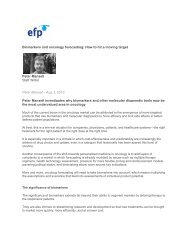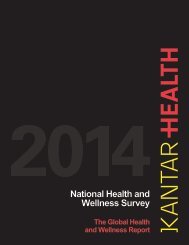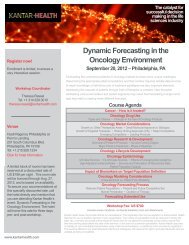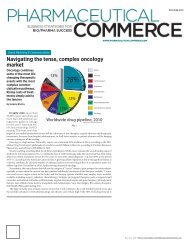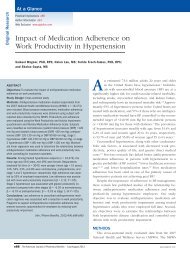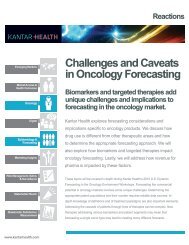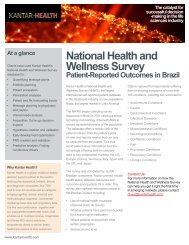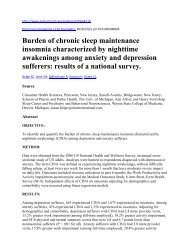Oncology Market Access - Channel Dynamics ... - Kantar Health
Oncology Market Access - Channel Dynamics ... - Kantar Health
Oncology Market Access - Channel Dynamics ... - Kantar Health
Create successful ePaper yourself
Turn your PDF publications into a flip-book with our unique Google optimized e-Paper software.
Reactions Roundtable<br />
Specialty distributors are<br />
evolving their business<br />
models to remain<br />
competitive and relevant.<br />
(EHR), inventory management services and<br />
practice workflow and financial management<br />
software, as well as access to their group<br />
purchasing organizations (GPOs) to obtain<br />
discounts on drugs; and they can offer<br />
manufacturers data and consulting for their<br />
products throughout their lifecycle, including<br />
reimbursement and product launch strategies,<br />
hub services, REMS operations and product<br />
marketing.<br />
Manufacturers should keep abreast of practice<br />
management solutions offered by SDs with<br />
the goal of understanding how they affect<br />
prescribing and whether and to what degree<br />
they tilt the balance of power toward the SDs<br />
and away from the manufacturers.<br />
Question 2: How has the increased<br />
availability of oral cancer therapies<br />
influenced or expanded the role of<br />
the specialty pharmacy?<br />
Specialty pharmacies (SPs) are commanding<br />
increased attention as oral therapy is more<br />
common and accepted. Physicians have become<br />
more willing to prescribe oral therapy despite<br />
no financial incentive to their practice—in part<br />
because of the services offered by SPs. Just<br />
two years ago, 60% of oncologists preferred<br />
to prescribe an IV drug over a therapeutically<br />
equivalent oral option. In 2012 this preference<br />
for IV drugs declined to just over 50% of<br />
oncologists 1 . As additional oral oncolytics become<br />
available and oncologists are prescribing them<br />
more, reliance on SPs is increasingly becoming a<br />
routine part of a practice’s daily business.<br />
Figure 2: % of All US Cancer Patients<br />
Treated with Branded Oral Oncolytics<br />
Figure 3: Expenditures on oral<br />
oncology are skyrocketing despite<br />
modest increases in utilization<br />
Oral <strong>Oncology</strong> Drug Statistics, 2011<br />
% of Total Drug Spend 2.3%<br />
∆ from 2010, Utilization 2.6%<br />
∆ from 2010, Inflation* 8.6%<br />
Source: <strong>Kantar</strong> <strong>Health</strong> CancerMPact ® US Patient Metrics<br />
Available from www.cancermpact.com.<br />
<strong>Access</strong>ed August 2012<br />
∆ from 2010, PMPM 18.6%<br />
*Inflation corresponds to changes in the cost of drugs; Unit<br />
cost inflation was driven almost exclusively by brand name<br />
drugs.<br />
Source: Prime Therapeutics<br />
PMPM = Per member per month<br />
1. <strong>Kantar</strong> <strong>Health</strong>; Oncologist Survey, June 2012<br />
ONC 4.15 If there were two treatments, one oral and one IV, that were essentially equivalent in efficacy and tolerability, would you be more likely to prescribe the oral or IV?<br />
ONC 4.15.1 Thinking back to two years ago, would you be more likely to prescribe the oral or IV for two treatments that were essentially equivalent in efficacy and tolerability?<br />
www.kantarhealth.com



